#Mysore Tiger
Text
ಕರ್ನಾಟಕ ಶಾಲಾ ಪಠ್ಯದಲ್ಲಿ ಟಿಪ್ಪು ವೈಭವೀಕರಣಕ್ಕೆ ಸಂಪೂರ್ಣ ಬ್ರೇಕ್! ಎರಡೇ ಸಾಲಿನಲ್ಲಿ ಪಾಠ ಮುಕ್ತಾಯ
ಕರ್ನಾಟಕ ಶಾಲಾ ಪಠ್ಯದಲ್ಲಿ ಟಿಪ್ಪು ವೈಭವೀಕರಣಕ್ಕೆ ಸಂಪೂರ್ಣ ಬ್ರೇಕ್! ಎರಡೇ ಸಾಲಿನಲ್ಲಿ ಪಾಠ ಮುಕ್ತಾಯ
ಬೆಂಗಳೂರು: ರಾಜ್ಯದಲ್ಲಿ ವಿವಾದಕ್ಕೆ ಕಾರಣವಾಗಿದ್ದ ಟಿಪ್ಪು (Tipu) ಪಠ್ಯ ಗೊಂದಲಕ್ಕೆ ಪಠ್ಯ ಪುಸ್ತಕ ಸಮಿತಿ (Karnataka School Syllabus Revision Committee) ತೆರೆ ಎಳೆದಿದೆ. ಶಾಲಾ ಪುಸ್ತಕದಲ್ಲಿ ಟಿಪ್ಪು ವೈಭವೀಕರಣಕ್ಕೆ ಸಂಪೂರ್ಣ ಬ್ರೇಕ್ ಬಿದ್ದಿದ್ದು, ಎರಡೇ ಎರಡು ಸಾಲಿನಲ್ಲಿ ಟಿಪ್ಪು ಕುರಿತ ಪಾಠ ಮುಕ್ತಾಯವಾಗುತ್ತದೆ. ಮೈಸೂರು ಹುಲಿ ಟಿಪ್ಪು ಸುಲ್ತಾನ್ ಎಂಬ ಬಿರುದು ಕೂಡಾ ಕಡಿತ ಮಾಡಲಾಗಿದೆ. ಪಠ್ಯದಲ್ಲಿ ಎಲ್ಲಿಯೂ ಮೈಸೂರು ಹುಲಿ ಟಿಪ್ಪು ಎಂಬ ಬಿರುದು ಬಳಸಿಲ್ಲ. ಈ ಹಿಂದೆ 6ನೇ…
View On WordPress
#BC Nagesh#Education Ministry#kannada news#karnataka latest news#Mysore Tiger#school syllabus#Tipu sultan
0 notes
Photo
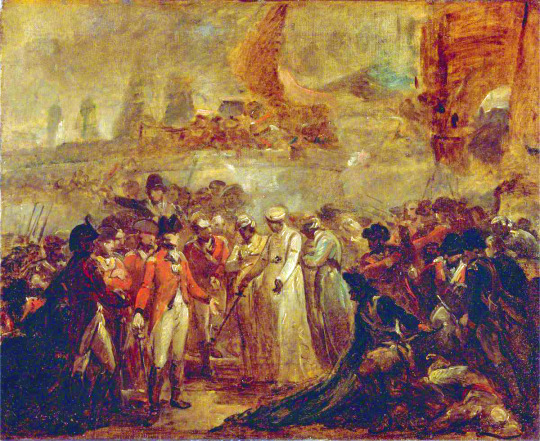
The Surrender of the Two Sons of Tipu Sahib, Sultan of Mysore, to Sir David Baird
Henry Singleton (1766–1839)
Yale Center for British Art
He was forced to deliver two of his sons as hostages until he paid in full three crores and thirty lakhs rupees fixed as war indemnity to the British for the campaign against him. He paid the amount in two instalments and got back his sons from Madras.
46 notes
·
View notes
Text

The Hornet No. 77, dated 27 February 1965. Tiger of Mysore! cover, artist unknown. The Tiger of Mysore also featured in the Sharpe's Tiger novel (as well as dozens of other things probably). DC Thomson.
6 notes
·
View notes
Video
youtube
WHITE TIGER VS BENGAL TIGER
#youtube#Big Cats#Felines#Tiger#White Tiger#Bengal Tiger#Mammal#Carnivore#Animal#wild animal#jungle#Whiter Tiger is colour variant#Mysore Zoo#Nature#Endangered Animals#Asian Animals#Indian Animals
4 notes
·
View notes
Text
Unique touch to Grand Prix badminton
Unique touch to Grand Prix badminton
By SS Shreekumar
League kicks off today; special features of the event are round-robin format and golden point
A unique format inaugural Grand Prix Badminton League will commence at the Karnataka Badminton Association hall here from Friday, with the final billed for August 21.
The League will be played in a round-robin format until the top four teams qualify for a double elimination stage. Each…

View On WordPress
#kodava tigers#malnad falcons#mangalore sharks#mysore panthers#prashanth reddy#satwik rankireddy#srikanth kidambi
0 notes
Text
CoD Baddies as Bears!
What if the bad guys were also bears! Part 3
See part 2 and 1 for 141 and good guys as bears
Even more bear facts because bears are love, bears are life. 🐻🐻❄️🧬
Makarov: Ussuri Brown Bear "Russian Grizzly Bear"
Ursus arctos lasiotus
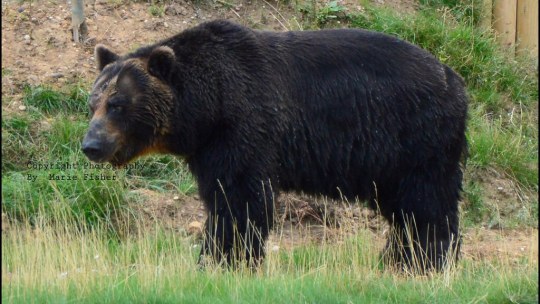
Also known as the Ezo Brown bear or Black Grizzly bear, this subspecies of Eurasian Brown Bear is one of the largest, with some individuals approaching the Kodiak Bear in size.
Similar to the Kamchatka Brown Bear, it differs with an elongated skull, longer nasal bones, elevated forehead and is darker in colour with some individuals being pure black.
Siberian (Amur) tigers and other bears are it's only natural predators, with documented tiger and bear interspecific competitions. Ussuri brown bears will often scavenge tiger kills and or kill smaller tigers, while Tigers are known to hunt young and sub-adult bears (bears making a significant portion of their diet).
Graves: Louisiana Black Bear
Ursus americanus luteolus

A subspecies* of the American Black Bear (U. a. americanus), the Louisiana Black Bear has been historically found in Louisiana, Mississippi, East Texas and Arkansas.
It is not substantially different from the American Black Bear, though it has a longer, flatter, narrower skull and larger molars in comparison. It's colouration is typically black, though some individuals have been known to be brown/red-brown cinnamon. It is Louisiana's official state mammal.
*The validity of this subspecies has been repeatedly debated.
Valeria: Sloth Bear "Indian Bear"
Melursus ursinus
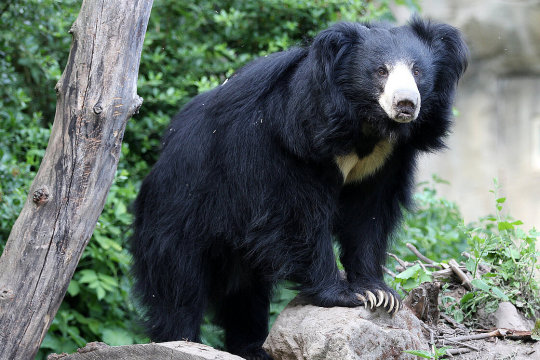
A native species to the Indian Subcontinent, this medium sized bear feeds on ants, termites and fruit. It is also called the "labiated bear" due to its long lower lip and palate which is used to eat insects.
It's fur is pure black aside from the white "Y" or "V" patch on its chest though this can be absent in some individuals. They are similar in size with the Asian Black Bear though distinguished with it's shaggy mane, white 'sickle' claws, and rangier build.
This species is the most aggressive to humans with the largest number of recorded attacks due to a combination of close human cohabitation and a theorised predisposition to aggressive behaviour from constant attacks by tigers, leopards, rhinos and elephants.
Captain Williamson in his Oriental Field Sports (1819) wrote of how sloth bears rarely killed their human victims outright, but would suck and chew on their limbs till they were reduced to bloody pulps.
They are not known to be man eaters despite attacking humans. One individual in Mysore (Mysuru), India was recorded to have killed at least 12 people and mutilated 24 before it's death in 1957.
Shepherd: Koala "Koala Bear"**
Phascolarctos cinereus
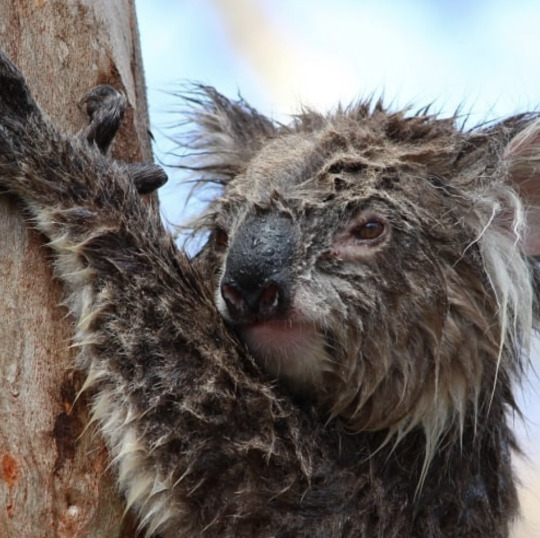
**not a bear
An arboreal marsupial native to Australia that feeds primarily on Eucalyptus leaves. Koalas are asocial with bonding only taking place between mothers and dependant offspring. They are largely sedentary and will sleep upwards to 20 hours a day.
The word "koala" came from the Dharug word "gula" - no water. The 'u' sound was originally written phonetically as 'oo' and then became 'oa'. The three syllable pronunciation may be erroneous as a result.
White settlers adopted the 'koala' indigenous loan word in reference to the animal, where it was also referred to as, the "native bear", or the "koala bear" due to its supposed bear-ish resemblance.
+
Info from Wikipedia. Please let me know if I screwed up somewhere. 🐻
#cod mwiii#cod mwii#call of duty modern warfare#call of duty#vladimir makarov#cod makarov#phillip graves#graves cod#valeria garza#valeria mw2#general shepherd#bears#bear facts#cod mw2#cod mw3
42 notes
·
View notes
Text
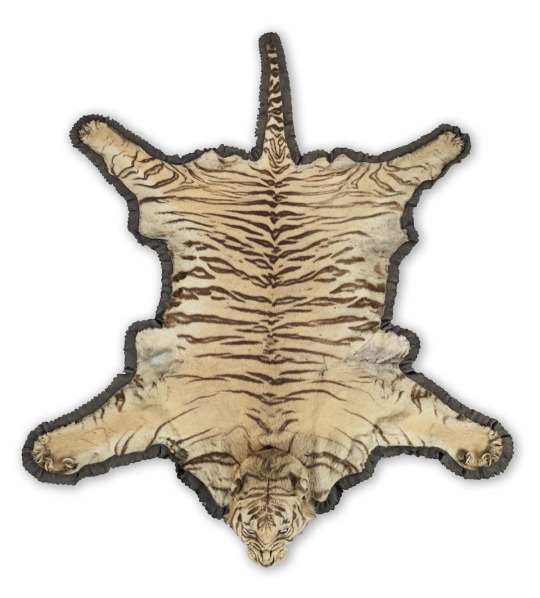

A good early 20th century Van Ingen tiger skin rug
the stuffed and mounted head with polished teeth and glass eyes, the back lined
with cotton canvas with stencilled mark VAN INGEN & VAN INGEN, MYSORE.
Bonhams
56 notes
·
View notes
Text
Scientific knowledge and technology played a significant role in the expansion of colonial rule in India and the consequent incorporation of the Indian sub-continent into the [commercialized, imperial] world-system [...]. The colonization of nature, territory and people in British India led to a mutually constitutive interplay [...].
By the time the East India Company managed to establish a foothold in Bengal in 1757, [...] [a]fter the acquisition of the formal rights to collect revenues in the states of Bengal, Bihar and Orissa, the issue of obtaining accurate information about the extent of the produce, the population and other social statistics assumed significance. The detailed scientific surveys [...] were possible due to the large number of amateur scientists employed by the Company. Over time, these surveys played a major role in the transformation of a trading company into a colonial state [...] and the incorporation of India into the modern world-system. [...]
---
Considered the founder of British geography, James Rennell arrived in India in 1760 barely three years after the decisive battle of Plassey. Rennell’s cartographic skills caught the attention of the governor of Bengal presidency, who was ‘anxious to inaugurate some system for correcting and revising the geography of Bengal’ [...]. Rennell’s mapping out in great detail the area under the Company was indispensable for the rationalization of the extraction of surplus, administrative strategies and techniques of control. [...] In 1777 he left for England, and two years later he published the Bengal Atlas that led to his election to the Royal Society. [...] With reference to the ‘science wars’, [...] Rennell’s work was also incorporated in the key text[s] of the time, C. Lyell’s Principles of Geology (1830) [...] [and] the work of [...] Humboldt and Carl Ritter. Rennell’s surveys contributed to the organized [...] surveys [across wider regions of India] that followed after the defeat of Tipu Sultan of Mysore in 1799. [...] [Mysore's] sustained resistance to British power had a major impact on the general consciousness in Britain. [...]
Thomas de Quincey extolled the virtues of the ‘British bulldog’ against [...] the tyrannical ‘Bengal tiger’ [...]. The scientific knowledge that emerged as a consequence of the surveys of Mysore contributed [...] to the consolidation of administrative power [...]. The key figures associated with the surveys [included] Colin Mackenzie [...]. Mackenzie’s ethnographic notes contributed to imperial perceptions of the [...] [people of South Asia] and the grid of anthropological knowledge through which administrative power was deployed. [...]
---
Nature, culture and colonial power were inextricably implicated in the production of scientific knowledge and of colonial society. [...] The establishment the Public Works Department in 1854 provided fresh impetus for the deployment of science and technology in grappling with problems precipitated by colonial rule. Declining revenues for the Company focused attention on gigantic irrigation and other public works projects. [...]
The irrigation projects were expanded to include the railways (1849), the telegraph (1852), and the postal system (1850). Together, they represented the largest state-sponsored enterprise undertaken anywhere at that time. Lord Dalhousie, under whose tenure these projects were inaugurated, declared the railways, the telegraph and the postal system as the ‘three great engines of social improvement’.
His predecessor William Bentinck had already termed the railways ‘the great engine of moral improvement’ in a country ‘cursed from one end to the other by the vice, the ignorance, [...] the barbarous and cruel customs that have been the growth of ages under every description of Asian misrule’ [...]. Later observers were to wax ever more eloquent on the role of the railways in the modernization of India. For W. A. Rogers of the Indian Civil Service, railways ‘are opening the eyes of the people … they teach them that speed attained is time, and therefore money, saved or made’ (Adas1989: 226). The importance of a network of railways, connecting the cotton plantations of the Deccan region to the ports became significant especially during the 'cotton famine' of 1846 [...].
---
Almost immediately after Dalhousie left India, secure in the belief that the double engines of moral improvement and legitimacy were at work, the rebellion of 1857 put an end to such expectations. The rebellion was partly triggered in response to the wide-ranging transformations [...] triggered off by the introduction of [these] new [colonial infrastructures] [...].
In the end, the rebellion was violently suppressed by the very technologies that had precipitated it in the first place. [...]
---
All text above by: Zaheer Baber. "Colonizing nature: scientific knowledge, colonial power and the incorporation of India into the modern world-system". British Journal of Sociology 52(1), pages 37-58. April 2001. [Bold emphasis and some paragraph breaks/contractions added by me. Presented here for commentary, teaching, criticism purposes.]
34 notes
·
View notes
Text
Oh, the irony of the followers of a fascist ideology, whose founder was a bootlicker for the British, insulting someone who actually died fighting the British. What a fucking joke this country has become

Remember Tipu Sultan, the Tiger of Mysore
#tipu sultan#india#original post#not incorrect quotes#desiblr#desi tumblr#desi tag#desi stuff#desi#islamophobia#british colonialism#colonialism
35 notes
·
View notes
Photo
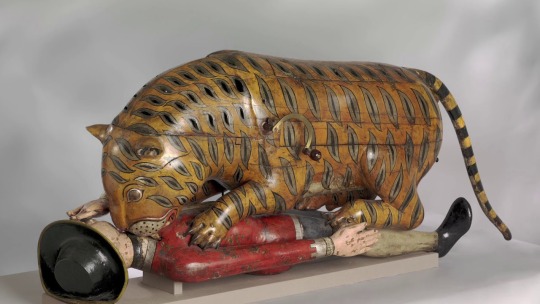
Tippoo's Tiger
'Tippoo's Tiger' was made for Tipu Sultan, ruler of Mysore in South India from 1782 to 1799. The tiger, an almost life-sized wooden semi-automaton, mauls a European soldier lying on his back. Concealed inside the tiger's body, behind a hinged flap, is an organ which can be operated by turning the handle next to it. This simultaneously makes the man's arm lift up and down and produces noises intended to imitate his dying moans.
Tigers and tiger stripes were part of the decoration of Tipu Sultan's possessions and anything made to proclaim his rule or personal association. Jewelled gold tiger head finials were on his throne, and tiger stripes were stamped onto his coinage, and his swords and guns incorporated tiger heads and stripes in their forms and ornamentation. Small bronze mortars made for his army were in the shape of crouching tigers, and the men who fired lethal iron-cased rockets against the British wore tunics with stripes woven into the fabric.
Tipu Sultan strongly resisted the attacks by British East India Company army on his kingdom. The Company had been established to trade, but by the late 18th century was extending British rule in India. It fought three wars against Mysore before making the final assault on Tipu's capital, Seringapatam, in 1799.
34 notes
·
View notes
Photo
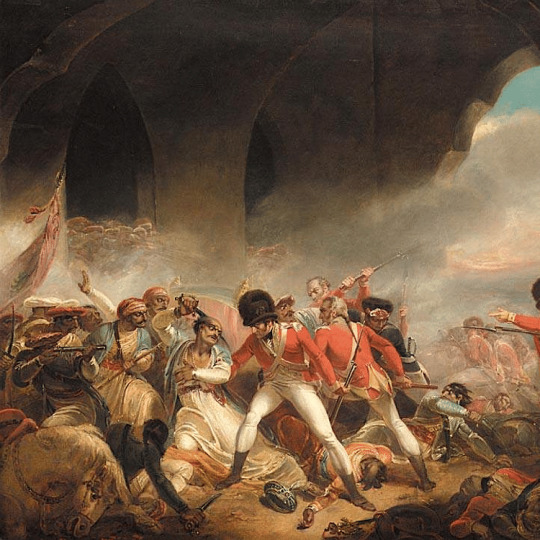
Anglo-Mysore Wars
The Four Anglo-Mysore Wars (1767-1799) were fought between the British East India Company (EIC) and the state of Mysore. Haidar Ali and his son Tipu Sultan, the "Tiger of Mysore", were relentless foes to British expansion in southern India but were eventually subdued by the triple alliance of the EIC, the Maratha Confederacy, and the Nizam of Hyderabad.
The four Anglo-Mysore wars were spread over four decades of battles, sieges, and ruthless psychological warfare:
Continue reading...
34 notes
·
View notes
Video
youtube
WHITE TIGER VS BENGAL TIGER
#youtube#Wildlife#Jingle Animals#Mammals#Carnivores#Apex Predtors#Tiger#White Tiger#Bengal Tiger#Black Stripes On Body#Mysore Zoo#Animaks In Mysore Zoo#Big Cats#Hunt Live Prey#Hide Prey
1 note
·
View note
Text
I’m kinda bored
So I’m going to talk about animals who have eaten humans
These animals are called ‘man-eaters’ and actually hunt for people. Of course a lot of man eaters are flesh eating animals. Because yea. Humans are made out of flesh
I’ll be talking about these few animals:
The beast of Gevaudan
The man eaters of Njombe
Kesagake the Sankebetsu bear
The leopard of Rudraprayag
The sloth bear of Mysore
The tigers of Chowgarh
The Tsavo man eaters
Man eaters of Kumaon
So yea, if you want to read about animals eating people, go ahead and wait here for a bit. If you want, you can read the meat eating horses post since it is quite similar to the other animals
6 notes
·
View notes
Text

Book review - Loot by Tania James
This one turned out to be a lot more boring than it seemed. It is a about a young, talented woodworker named Abbas from Srirangapatna, Mysore, whose work catches the eye of Tipu Sultan. Tipu Sultan enlists Abbas to work for him, under the apprenticeship of a French clockmaker named Lucien Du Leze. Together, they build a one-of-a-kind musical automaton of a tiger killing a British soldier, which is later stolen as a war prize when the British attack Mysore and kill Tipu Sultan. Abbas later moves to France, where he learns that the tiger has been given to the wife of one of the British soldiers. He goes to England with Jehanne, a girl he knew from his childhood that also went to France, to try and get the tiger back.
..............................................................................................................................
I thought this book had a very interesting concept, but there are huge gaps in time left unexplained, random deaths that didn't make much sense, and an anticlimactic ending (its described as a heist novel but Abbas and Jehanne ultimately don't get the Tiger back, and for all his prodigious talent Abbas becomes a dollmaker). It did have a wry sense of humor that I enjoyed, though.
5 notes
·
View notes
Text
attempt #903843 my husband tried to surprise me only to have me ruin it by correctly guessing what the surprise is.. said he found a way to let me (along with some other people probably) at the mysore palace do a special tour with a few extra rooms open for viewing
“you’re NOT gonna believe what I saw in the room. your mind will be blown!!”
me: what, you saw crates of jewels?
him: you know i dont care about that
me: you touched the throne?
him: you can do that any time, it’s no big deal.. seriously you’re not gonna guess what i saw
me after 30 seconds of thinking: it’s the taxidermied animals isn’t it
him: .......................
me: *trying not to burst his bubble by telling him they had them displayed in the other old building* sooooo did you touch the tiger?
him: i put my head in its mouth too
12 notes
·
View notes